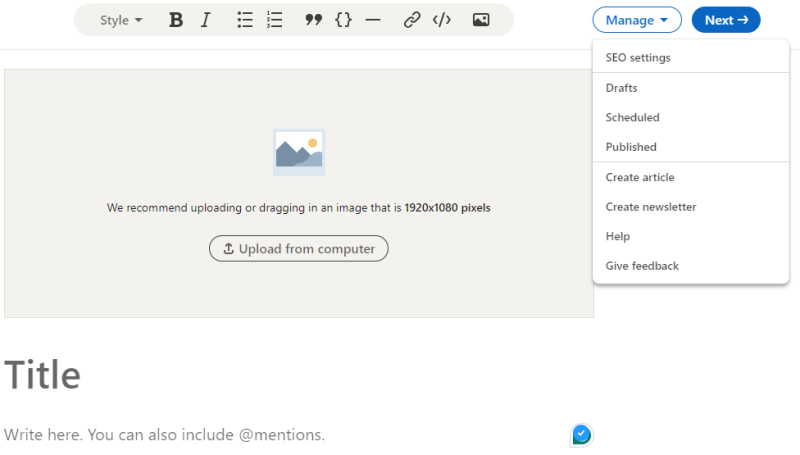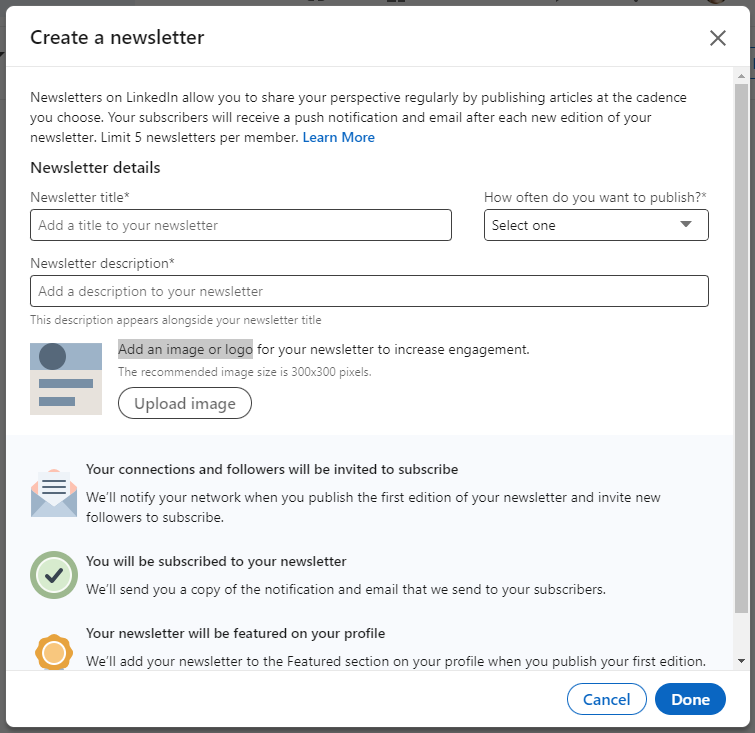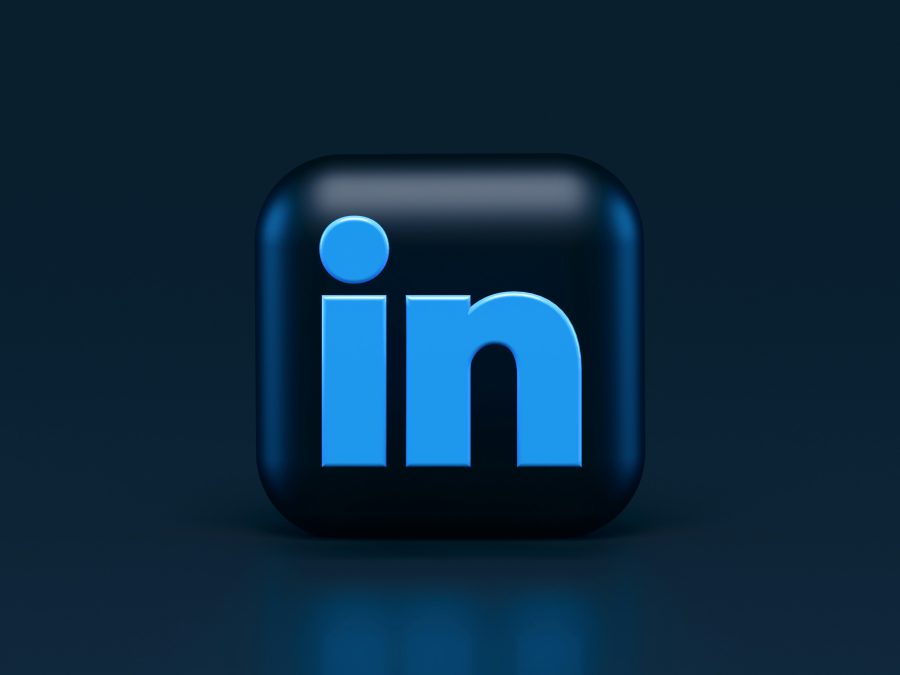LinkedIn newsletter - table of contents
- What is a LinkedIn newsletter?
- The difference between LinkedIn newsletter, article, and post
- LinkedIn newsletter vs. traditional newsletter
- Is it worth creating a newsletter?
- Why is it worthwhile to publish a newsletter on LinkedIn?
- How to create a newsletter on LinkedIn?
- How to begin publishing a newsletter on LinkedIn?
- LinkedIn newsletter examples
- Summary
Until recently, to create a newsletter, companies had to invest in dedicated programs such as GetResponse, MailChimp, or FreshMail. Otherwise, the sent messages could be received by email servers as spam. However, we now have an interesting alternative to traditional newsletter programs—LinkedIn newsletters. What does this feature entail and what possibilities does it offer?
What is a LinkedIn newsletter?
A newsletter on LinkedIn is a feature provided by the platform for sending regularly published articles. Subscribers to the newsletter receive push notifications each time the author publishes a new article, either in the app and/or via email.
Access to the newsletter feature is available to users with the enabled creator mode. However, LinkedIn is working on expanding the functionality to other users as well. To be able to use the newsletter, certain criteria must be met, such as:
- having over 150 followers/connections,
- having a positive history of adherence to Professional Community Policies,
- recently sharing content on LinkedIn (including posts, events, articles, etc.).
After publishing the first newsletter, LinkedIn automatically generates a page for the newsletter, which is accessible to all platform users (even those not logged in). However, to subscribe to the newsletter, you must log in or create an account on LinkedIn.
The difference between LinkedIn newsletter, article, and post
Newsletters, articles, and posts on LinkedIn are different content formats that users can publish on the platform. How do they differ?
- A post on LinkedIn is the basic format shared on a LinkedIn profile. There is a limit of 3000 characters. The post may contain a link, photo, video, poll, or document.
- Articles on LinkedIn are longer forms of publication visible in the Activity section on the profile. The author has control over the style and formatting of the article, such as changing fonts, adding bullet points, or block quotes. After publishing, the article is available to profile followers, and it can be shared, for example, on Facebook or Twitter.
- LinkedIn newsletters are regular publications sent directly to newsletter subscribers, i.e. people who have voluntarily signed up for the newsletter.
The above formats can therefore be used for different purposes and to distribute different types of content.
LinkedIn newsletter vs. traditional newsletter
| |
It doesn’t require having an additional tool. The feature is available for all users with the creator mode enabled (soon also for other members) for free — after meeting certain conditions. |
It requires purchasing a newsletter program. Some tools offer a free trial version or free access with limitations on the number of contacts. |
|---|---|---|
| |
The author of the newsletter doesn’t need to have their own contact database. They build it based on LinkedIn users. However, they are not the owner of the newsletter, which means they don’t have access to subscriber data. In the event of the feature being withdrawn or the account being blocked, the creator may lose everything related to the newsletter. |
The newsletter author is its owner and has access to all contacts. However, they must possess a database of people to whom the newsletter will be sent. |
| |
LinkedIn newsletters are indexed by the Google search engine. When properly optimized, they can appear in search results. |
In a traditional newsletter, sent content is not indexed by search engines. |
| |
The LinkedIn newsletter is a relatively new and still unfamiliar feature. Therefore, recipients may not know that a particular brand has its newsletter. |
Traditional newsletters are well-known, so recipients know where to find subscription information (usually on the brands’ websites). |
| |
In the case of a LinkedIn newsletter, even non-members can view the newsletter page to see if the topics interest them before deciding to subscribe. |
Traditional newsletters don’t let subscribers preview messages, so they have to trust brands and see if the info is valuable. |
Is it worth creating a newsletter?
First, let’s consider if people still use newsletters. Does a newsletter still make sense these days? Statistics confirm that in both B2C and B2B marketing, traditional email newsletters are one of the most effective channels for content distribution and revenue generation (source).
Newsletters attract subscribers from different generations, especially Gen Z, Millennials, and Gen X (95% of representatives from these generations receive newsletters). The popularity of this content distribution method is also confirmed by the average open rate, which is nearly 22% across all industries. The highest engagement rate occurs with newsletters about shopping (83%), finances (43%), and challenging topics (38%), such as politics or business (source).
Why is it worthwhile to publish a LinkedIn newsletter?
Creating a newsletter (not only on LinkedIn) has many benefits. Among the general advantages of newsletters, we can mention:
- building an audience group genuinely interested in a specific topic and the content being created,
- acquiring a communication channel through which you can quickly reach customers with important messages, such as ongoing promotions or new product features,
- building relationships with recipients through regular and direct contact with customers,
- establishing the company’s position as an expert in a particular field, which fosters trust in the brand among customers,
- access to data that allows monitoring of recipient activity, drawing conclusions, and improving the strategy.
Apart from the general benefits mentioned above, LinkedIn newsletters have additional advantages:
- They are simpler and less demanding to create than traditional newsletters — they do not require having your own contact database or access to dedicated, often paid programs. The newsletter can be prepared using a platform that most companies, personal brands, or marketers already use on a daily basis.
- They increase brand visibility on LinkedIn. LinkedIn is more inclined to promote accounts that create regular content (newsletters, articles, posts). As a reward for engagement, creators can reach an increasingly wider audience.
- Subscribers receive notifications on LinkedIn and via email every time a new article appears in the newsletter. This prevents your content from getting lost in the flood of information that readers receive daily in their inbox.
- Recently, the platform introduced new features that allow for more accurate measurement of results and tracking of recipient activity, as well as learning who they are, where they come from, and what professional titles they hold, enabling effective audience segmentation.
The LinkedIn newsletter is still a new solution, steadily developed by the platform and increasingly used by brands. Experts speculate that this feature will gain popularity. So let’s move on to how to use the LinkedIn newsletter.
How to create a newsletter on LinkedIn?
The process of creating your own newsletter on LinkedIn involves three simple steps described below.
- Turn on creator mode
- Set up your newsletter
- Fill in the details
- Newsletter title — the title should grab attention and be consistent with the topics that will be covered in the newsletter.
- How often do you want to publish? — choose the publication frequency based on your capabilities and resources, as well as the topic to be covered in the newsletter (you can always change the schedule if needed).
- Newsletter description —include keywords that will help readers find your newsletter,
- Add an image or logo — it should be consistent with the brand image and attractive, grabbing the attention of the audience.
As mentioned earlier, the newsletter feature is currently available to users with creator mode enabled (this may change soon). Go to your profile, then in the “Resources” section, enable creator mode.

In addition to creator mode, you need to have a minimum of 150 followers/connections and recent activity on your profile, such as adding a post.
If you meet the above conditions, click Write article at the top of the homepage.

Click the Manage dropdown menu near the upper right and select Create newsletter.

Next, you will be asked to fill in the details, such as:
After filling in all the information, click the “Done” button.

How to begin publishing a newsletter on LinkedIn?
Do you want to create a valuable newsletter that will be eagerly read by subscribers? We’ve prepared some tips to help you achieve this.
Why do you want to create a newsletter on LinkedIn?
Think about what you want to accomplish with it. For example, the goal might be to build a contact base, increase brand trust, or establish yourself as an expert in a particular field. It’s important that the goal you choose is consistent with your company’s business objectives and the resources you can devote to such activities. Then move on to developing a strategy – the following points will help.
How to choose a niche for your newsletter?
Before creating a newsletter on LinkedIn, find out who uses the platform and what industries they’re in. Most users are Millennials (60%), with 57.2% male and 42.8% female (source). Answer the question, then, is your target audience on LinkedIn?
What to write in a newsletter?
In this step, think about the issues your audience faces and how you can help. Clearly explain what subscribers will get in your newsletter. Make sure it’s unique and valuable to give them a reason to subscribe. Avoid repeating information in the same way, as it won’t keep them engaged.
What should a good newsletter look like?
Pay attention to the readability and attractiveness of the content you prepare. A long block of text won’t be engaging for the audience, so divide it into shorter paragraphs. Where possible, use bullet points, lists, quotes, bold or italic text. A LinkedIn newsletter isn’t limited to just text — you can also include videos, graphics, or links.
Also, remember to include a Call To Action (CTA). It could be encouraging recipients to leave a comment, visit your website, or purchase a specific product. You create the newsletter for a specific purpose, and appropriate CTAs will help you achieve that goal.
LinkedIn newsletter examples
Are you looking for inspiration for your newsletter? Here are a few sample newsletters worth observing on LinkedIn.
Business & Technology Snapshot
The newsletter created by the company TUATARA. Subscribers receive a monthly article summarizing the latest news in technology and business. If you want to know about the developments in AI, the dominant technological trends in various industries, and how to leverage new opportunities in your company, it’s worth subscribing to this newsletter.
Daniel Burrus is an American business advisor who shares his knowledge in a weekly newsletter. He covers topics related to management, leadership, technology, and the impact of these factors on a company’s success.
Subscribers to this newsletter receive weekly tips and practical advice on advertising, web analytics, design, and other topics related to digital marketing.
This is the newsletter of the British news channel BBC News. Monthly articles cover topics related to work, career, and business. The articles refer to current events that impact the job market, such as the influence of remote work, the use of ChatGPT, etc.
Summary
LinkedIn has various uses beyond recruitment, including marketing and business. Newsletters on LinkedIn are becoming increasingly popular, thanks in part to the platform’s efforts to enhance features like data analysis.
If you’re starting your newsletter journey or know that your target audience is on LinkedIn, consider creating your own newsletter. This way, with low effort, you can reach a wide audience, build your expertise, and create another valuable communication channel with customers.

If you like our content, join our busy bees community on Facebook, Twitter, LinkedIn, Instagram, YouTube, Pinterest, TikTok.
Author: Izabela Pieta
Marketing & Social Media Specialist
In her work, she navigates the ever-changing marketing trends and innovations across various industries, including HR, e-commerce, and IT. She leverages this knowledge and observations to develop creative solutions for effective marketing strategies.
Social media in business:
- Threads vs Twitter (X) - pros and cons. Which platform to use in 2024?
- A broadcast channel on Instagram. How to use this feature in business?
- Why is it worth publishing a newsletter on LinkedIn? LinkedIn newsletters step by step
- Is it worth creating Instagram Stories for business?
- Snapchat. Don’t forget about this platform when developing your marketing strategy
- Twitch vs YouTube. Where to promote your brand?
- Instant messengers and how to use them to promote your company


















